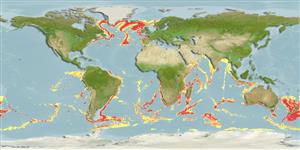>
Stomiiformes (Lightfishes and dragonfishes) >
Stomiidae (Barbeled dragonfishes) > Astronesthinae
Etymology: Borostomias: Greek, boros, -a, -on = gluttonous + Greek, stomías, -ou = a tough, hard -mouthed horse (Ref. 45335).
More on author: Lönnberg.
Environment: milieu / climate zone / depth range / distribution range
Ecologia
marino batidemersale; oceanodromo (Ref. 51243); distribuzione batimetrica 300 - 2630 m (Ref. 5169). Deep-water; 66°N - 66°S, 180°W - 180°E
Eastern Atlantic: Nunavut south to Bay of Biscay including western Mediterranean. Elsewhere, Southern Ocean from 35°S to 65°S.
Size / Peso / Age
Maturity: Lm ? range ? - ? cm
Max length : 30.0 cm SL maschio/sesso non determinato; (Ref. 5169)
Short description
Chiavi di identificazione | Morfologia | Morfometria
Spine dorsali (totale) : 0; Raggi dorsali molli (totale) : 9 - 13; Spine anali: 0; Raggi anali molli: 12 - 17. Body black in color, lacks well developed pale patches (Ref. 3982). Lack of high arch in photophores behind anal base and presence of double postorbital organ (Ref. 37473).
An oceanic and mesopelagic species usually found deeper than 500 m during the day (Ref. 2802). Feeds on midwater fishes and crustaceans (Ref. 2802).
Life cycle and mating behavior
Maturità | Riproduzione | Deposizione | Uova | Fecundity | Larve
Gibbs, R.H. Jr., 1984. Astronesthidae. p. 325-335. In P.J.P. Whitehead, M.-L. Bauchot, J.-C. Hureau, J. Nielsen and E. Tortonese (eds.) Fishes of the north-eastern Atlantic and the Mediterranean. UNESCO, Paris. Vol. 1. (Ref. 2802)
IUCN Red List Status (Ref. 130435: Version 2024-2)
Threat to humans
Harmless
Human uses
Pesca: commerciale
Strumenti
Special reports
Download XML
Fonti Internet
Estimates based on models
Preferred temperature (Ref.
123201): 2.2 - 8.3, mean 4.9 °C (based on 1349 cells).
Phylogenetic diversity index (Ref.
82804): PD
50 = 0.5156 [Uniqueness, from 0.5 = low to 2.0 = high].
Bayesian length-weight: a=0.00417 (0.00171 - 0.01014), b=3.05 (2.84 - 3.26), in cm total length, based on LWR estimates for this (Sub)family-body shape (Ref.
93245).
Trophic level (Ref.
69278): 3.6 ±0.54 se; based on food items.
Resilienza (Ref.
120179): Medio, tempo minimo di raddoppiamento della popolazione 1.4 - 4.4 anni (Preliminary K or Fecundity.).
Fishing Vulnerability (Ref.
59153): Low to moderate vulnerability (27 of 100).
Nutrients (Ref.
124155): Calcium = 35 [21, 84] mg/100g; Iron = 0.533 [0.248, 1.072] mg/100g; Protein = 16.4 [15.3, 17.6] %; Omega3 = 0.362 [0.181, 0.745] g/100g; Selenium = 24 [9, 55] μg/100g; VitaminA = 18.9 [3.9, 91.0] μg/100g; Zinc = 0.419 [0.268, 0.652] mg/100g (wet weight);
